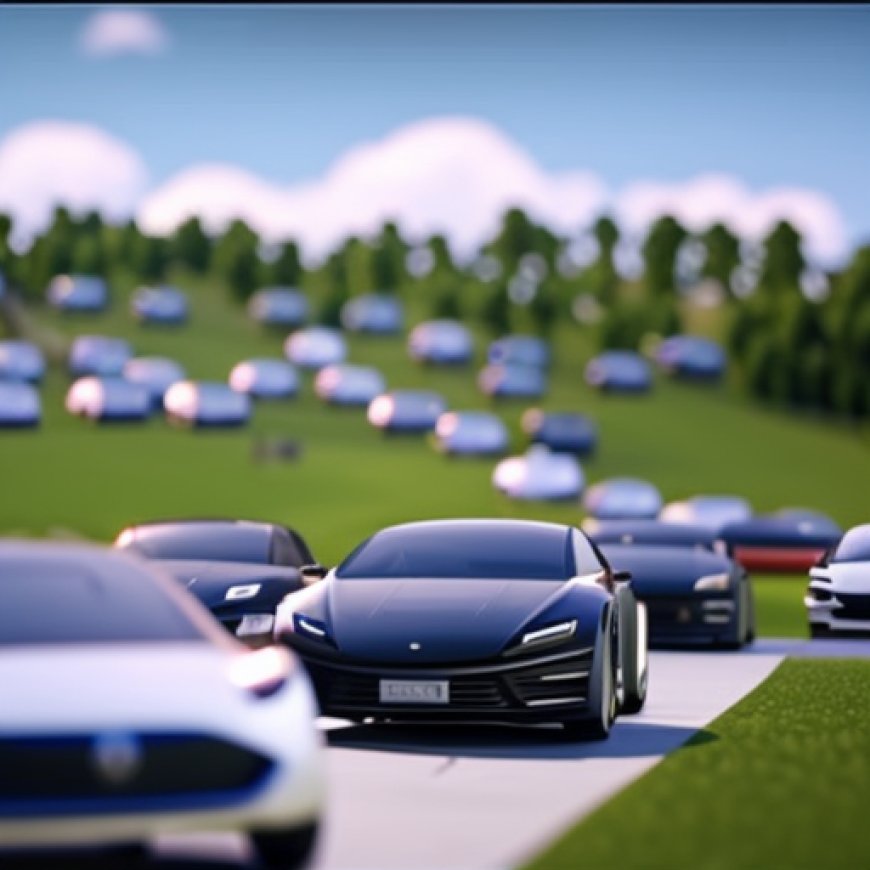Electric cars credited with lower CO2 emissions in US neighborhoods
Electric cars credited with lower CO2 emissions in US neighborhoods FRANCE 24 English


Booming Use of Electric Vehicles in California Reduces CO2 Emissions, Study Shows
Los Angeles (AFP) – The booming use of electric vehicles in parts of California is reducing CO2 emissions in those areas, a study showed Thursday, bolstering a key pillar of the state’s drive towards net zero.
Issued on:
Modified:
2 min
Advertising
Sustainable Development Goals (SDGs)
- Goal 7: Affordable and Clean Energy
- Goal 11: Sustainable Cities and Communities
- Goal 13: Climate Action
Scientists at the University of California, Berkeley, say a network of sensors set up around the San Francisco Bay Area — where Teslas and other EVs are a common sight — has logged a small but steady drop in the volume of planet-warming carbon dioxide being pumped out every year.
“We show from atmospheric measurements that adoption of electric vehicles is working, that it’s having the intended effect on CO2 emissions,” said chemistry professor Ronald Cohen, the study’s lead author.
Carbon dioxide is one of the main contributors to global warming, the human-caused phenomenon of rising temperatures that is increasingly playing havoc with global weather patterns.
Scientists agree that nations have to rapidly shift away from burning fossil fuels in order to keep global temperature rises to a manageable level and avoid the worst environmental calamities.
More than two-thirds of CO2 emissions come from cities, but granular information about those emissions is scant — leaving policymakers guessing at how best to tamp them down.
Cohen’s network of dozens of sensors, which he started installing in 2012, has started to change that. It logged a 1.8 percent drop in emissions every year over a five-year period.
Cross-referencing this data with vehicle registration information in the Bay Area — where almost one in every 20 vehicles is electric or hybrid — led Cohen and his team to conclude electrification was having a measurable effect.
“The state of California has an ambition to be net zero in 2045 and that requires a decrease (in emissions) of a little more than three and a half percent per year for the next 20 plus years,” Cohen told AFP.
“1.8 percent per year is half the rate that we need to decrease. But I think it’s an amazing down payment on our way to the right future.”
‘Good news’
California’s ambitious plan for net zero — where CO2 production is vastly reduced and any remaining emissions are offset — puts it ahead of the 2050 target of the United States as a whole.
The state, which if it were a country would have the fifth-biggest economy in the world, has some of the strictest environmental standards in the United States, including a plan to ban the sale of new gas-powered cars by 2035.
Cohen, who plans to roll out his sensor network in Los Angeles, in Providence, Rhode Island and in the Scottish city of Glasgow, acknowledges that the Bay Area’s enthusiastic adoption of EVs in a state sympathetic to the cause makes it an atypical case study.
“This is what a good news story looks like in the place that’s most aggressive,” he said.
“But it shows it’s possible. It shows both how we can make measurements that allow us to report on how cities are doing with their policies, and it shows us those policies can make changes that are observable at scale,” he said.
© 2024 AFP
SDGs, Targets, and Indicators
-
SDG 13: Climate Action
- Target 13.2: Integrate climate change measures into national policies, strategies, and planning
- Indicator 13.2.1: Number of countries that have integrated climate change measures into national policies, strategies, and planning
-
SDG 11: Sustainable Cities and Communities
- Target 11.6: Reduce the adverse per capita environmental impact of cities, including by paying special attention to air quality and municipal and other waste management
- Indicator 11.6.2: Annual mean levels of fine particulate matter (e.g. PM2.5) in cities (population weighted)
-
SDG 7: Affordable and Clean Energy
- Target 7.3: Double the global rate of improvement in energy efficiency
- Indicator 7.3.1: Energy intensity measured in terms of primary energy and GDP
Analysis:
The issues highlighted in the article are connected to multiple Sustainable Development Goals (SDGs). The main SDGs addressed are:
1. SDG 13: Climate Action
The article discusses the reduction of CO2 emissions through the adoption of electric vehicles (EVs) in California. This aligns with SDG 13, which aims to take urgent action to combat climate change and its impacts.
2. SDG 11: Sustainable Cities and Communities
The article mentions that more than two-thirds of CO2 emissions come from cities, emphasizing the importance of addressing environmental impacts in urban areas. This relates to SDG 11, which focuses on making cities inclusive, safe, resilient, and sustainable.
3. SDG 7: Affordable and Clean Energy
The article highlights the adoption of electric vehicles as a means to reduce CO2 emissions, contributing to the transition towards clean energy sources. This aligns with SDG 7, which aims to ensure access to affordable, reliable, sustainable, and modern energy for all.
Based on the article’s content, specific targets under these SDGs can be identified:
1. Target 13.2: Integrate climate change measures into national policies, strategies, and planning
The adoption of electric vehicles in California demonstrates the integration of climate change measures into the state’s policies and planning, as it contributes to reducing CO2 emissions.
2. Target 11.6: Reduce the adverse per capita environmental impact of cities
The use of electric vehicles in cities helps to reduce air pollution and mitigate the adverse environmental impact caused by transportation. This aligns with the target of reducing the per capita environmental impact of cities.
3. Target 7.3: Double the global rate of improvement in energy efficiency
The adoption of electric vehicles contributes to improving energy efficiency by reducing reliance on fossil fuels for transportation. This supports the target of doubling the global rate of improvement in energy efficiency.
The article mentions or implies several indicators that can be used to measure progress towards the identified targets:
1. Indicator 13.2.1: Number of countries that have integrated climate change measures into national policies, strategies, and planning
The article highlights California’s adoption of electric vehicles as part of its climate change measures. By tracking the number of countries or regions that implement similar policies, progress can be measured towards integrating climate change measures into national policies, strategies, and planning.
2. Indicator 11.6.2: Annual mean levels of fine particulate matter (e.g. PM2.5) in cities (population weighted)
The adoption of electric vehicles can contribute to reducing air pollution in cities. Monitoring the annual mean levels of fine particulate matter, such as PM2.5, can provide an indicator of progress in reducing the adverse environmental impact of cities.
3. Indicator 7.3.1: Energy intensity measured in terms of primary energy and GDP
By transitioning to electric vehicles, the energy intensity in the transportation sector can be measured in terms of primary energy and GDP. This indicator can help track progress towards doubling the global rate of improvement in energy efficiency.
Table: SDGs, Targets, and Indicators
| SDGs | Targets | Indicators |
|---|---|---|
| SDG 13: Climate Action | Target 13.2: Integrate climate change measures into national policies, strategies, and planning | Indicator 13.2.1: Number of countries that have integrated climate change measures into national policies, strategies, and planning |
| SDG 11: Sustainable Cities and Communities | Target 11.6: Reduce the adverse per capita environmental impact of cities | Indicator 11.6.2: Annual mean levels of fine particulate matter (e.g. PM2.5) in cities (population weighted) |
| SDG 7: Affordable and Clean Energy | Target 7.3: Double the global rate of improvement in energy efficiency | Indicator 7.3.1: Energy intensity measured in terms of primary energy and GDP |
Behold! This splendid article springs forth from the wellspring of knowledge, shaped by a wondrous proprietary AI technology that delved into a vast ocean of data, illuminating the path towards the Sustainable Development Goals. Remember that all rights are reserved by SDG Investors LLC, empowering us to champion progress together.
Source: france24.com

Join us, as fellow seekers of change, on a transformative journey at https://sdgtalks.ai/welcome, where you can become a member and actively contribute to shaping a brighter future.







